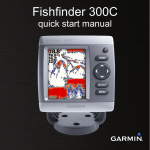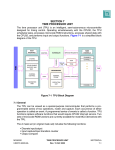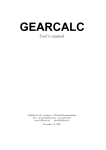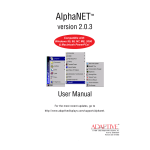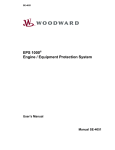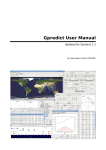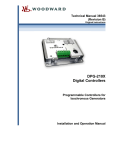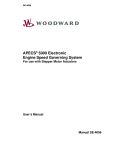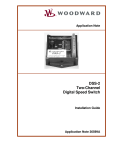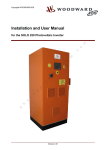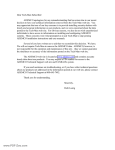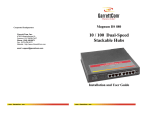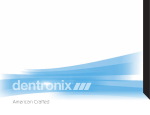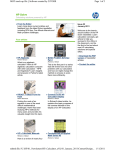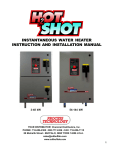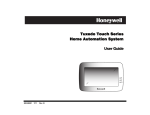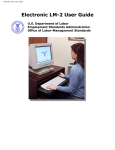Download ProTech 203 Overspeed Protection System
Transcript
Installation and Operation Manual ProTech® 203 Overspeed Protection System 8200-200, -201, -202, -203, -204, -205, 9907-344, -345 Manual 85205 (Revision F) WARNING—DANGER OF DEATH OR PERSONAL INJURY WARNING—FOLLOW INSTRUCTIONS Read this entire manual and all other publications pertaining to the work to be performed before installing, operating, or servicing this equipment. Practice all plant and safety instructions and precautions. Failure to follow instructions can cause personal injury and/or property damage. WARNING—OUT-OF-DATE PUBLICATION This publication may have been revised or updated since this copy was produced. To verify that you have the latest revision, be sure to check the Woodward website: www.woodward.com/pubs/current.pdf The revision level is shown at the bottom of the front cover after the publication number. The latest version of most publications is available at: www.woodward.com/publications If your publication is not there, please contact your customer service representative to get the latest copy. WARNING—OVERSPEED PROTECTION The engine, turbine, or other type of prime mover should be equipped with an overspeed shutdown device to protect against runaway or damage to the prime mover with possible personal injury, loss of life, or property damage. The overspeed shutdown device must be totally independent of the prime mover control system. An overtemperature or overpressure shutdown device may also be needed for safety, as appropriate. WARNING—PROPER USE Any unauthorized modifications to or use of this equipment outside its specified mechanical, electrical, or other operating limits may cause personal injury and/or property damage, including damage to the equipment. Any such unauthorized modifications: (i) constitute "misuse" and/or "negligence" within the meaning of the product warranty thereby excluding warranty coverage for any resulting damage, and (ii) invalidate product certifications or listings. CAUTION—POSSIBLE DAMAGE TO EQUIPMENT OR PROPERTY CAUTION—BATTERY CHARGING To prevent damage to a control system that uses an alternator or battery-charging device, make sure the charging device is turned off before disconnecting the battery from the system. CAUTION—ELECTROSTATIC DISCHARGE Electronic controls contain static-sensitive parts. Observe the following precautions to prevent damage to these parts. • Discharge body static before handling the control (with power to the control turned off, contact a grounded surface and maintain contact while handling the control). • Avoid all plastic, vinyl, and Styrofoam (except antistatic versions) around printed circuit boards. • Do not touch the components or conductors on a printed circuit board with your hands or with conductive devices. • IMPORTANT DEFINITIONS A WARNING indicates a potentially hazardous situation which, if not avoided, could result in • A CAUTION indicates a potentially hazardous situation which, if not avoided, could result in • A NOTE provides other helpful information that does not fall under the warning or caution death or serious injury. damage to equipment or property. categories. Revisions—Text changes are indicated by a black line alongside the text. Woodward Governor Company reserves the right to update any portion of this publication at any time. Information provided by Woodward Governor Company is believed to be correct and reliable. However, no responsibility is assumed by Woodward Governor Company unless otherwise expressly undertaken. © Woodward 1997 All Rights Reserved Manual 85205 ProTech 203 Overspeed Protection System Contents ELECTROSTATIC DISCHARGE AWARENESS ..................................................III REGULATORY COMPLIANCE........................................................................ IV CHAPTER 1. GENERAL INFORMATION ........................................................... 1 Introduction.............................................................................................................1 Description..............................................................................................................1 Applications ............................................................................................................1 References .............................................................................................................2 CHAPTER 2. INSTALLATION.......................................................................... 3 Unpacking...............................................................................................................3 Power Requirements ..............................................................................................3 Location Considerations.........................................................................................3 Shielded Wiring ......................................................................................................3 Plant Wiring ............................................................................................................4 Installation Check-Out Procedure ..........................................................................5 CHAPTER 3. DESCRIPTION........................................................................... 7 Introduction.............................................................................................................7 Specifications .........................................................................................................8 Modes of Operation ..............................................................................................10 Power Supply Description ....................................................................................11 CHAPTER 4. CONFIGURATION AND OPERATION .......................................... 13 Introduction...........................................................................................................13 Programming ........................................................................................................15 ProTech 203 Programming Worksheet................................................................16 Operation..............................................................................................................17 CHAPTER 5. TROUBLESHOOTING AND USER REPAIRS ................................ 21 Troubleshooting....................................................................................................21 User Repairs.........................................................................................................23 CHAPTER 6. SERVICE OPTIONS ................................................................. 28 Product Service Options.......................................................................................28 Returning Equipment for Repair...........................................................................29 Replacement Parts ...............................................................................................30 How to Contact Woodward...................................................................................30 Engineering Services ...........................................................................................31 Technical Assistance............................................................................................32 DECLARATIONS ......................................................................................... 33 Woodward i ProTech 203 Overspeed Protection System Manual 85205 Illustrations and Tables Figure 2-1. Plant Wiring Diagram ...........................................................................4 Figure 2-2. Routing and Stress Relief for Field Wiring Entering the ProTech 203 System ...............................................................................................6 Figure 3-1. Outline Drawing of ProTech 203 System.............................................7 Figure 3-2. Interposing Relay Field Wiring ...........................................................10 Figure 3-3. Voter Relay Configuration..................................................................11 Figure 3-4. Block Diagram of One Unit of ProTech 203 System .........................12 Figure 4-1. ProTech 203 Front Panel...................................................................13 Figure 4-2. Method 1 Block Diagram....................................................................17 Figure 4-3. Method 2 Block Diagram....................................................................18 Figure 5-1. ProTech System Front Door ..............................................................24 Figure 5-2. Unit Covers Inside the ProTech Device.............................................24 Figure 5-3. Board Locations .................................................................................26 Figure 5-4. Display Boards ...................................................................................27 Table 1-1. De-energize-to-Trip ProTech Models....................................................2 Table 1-2. Energize-to-Trip ProTech Models .........................................................2 Table 1-3. Voltage Ranges.....................................................................................2 Table 4-1. Allowable Ranges ...............................................................................14 Table 4-2. Start Mode Options .............................................................................19 Table 4-3. Trip Causes .........................................................................................20 Table 5-1. Power Supply Fuse Data ....................................................................23 ii Woodward Manual 85205 ProTech 203 Overspeed Protection System Electrostatic Discharge Awareness All electronic equipment is static-sensitive, some components more than others. To protect these components from static damage, you must take special precautions to minimize or eliminate electrostatic discharges. Follow these precautions when working with or near the control. 1. Before doing maintenance on the electronic control, discharge the static electricity on your body to ground by touching and holding a grounded metal object (pipes, cabinets, equipment, etc.). 2. Avoid the build-up of static electricity on your body by not wearing clothing made of synthetic materials. Wear cotton or cotton-blend materials as much as possible because these do not store static electric charges as much as synthetics. 3. Keep plastic, vinyl, and Styrofoam materials (such as plastic or Styrofoam cups, cup holders, cigarette packages, cellophane wrappers, vinyl books or folders, plastic bottles, and plastic ash trays) away from the control, the modules, and the work area as much as possible. 4. Do not remove the printed circuit board (PCB) from the control cabinet unless absolutely necessary. If you must remove the PCB from the control cabinet, follow these precautions: • Do not touch any part of the PCB except the edges. • Do not touch the electrical conductors, the connectors, or the components with conductive devices or with your hands. • When replacing a PCB, keep the new PCB in the plastic antistatic protective bag it comes in until you are ready to install it. Immediately after removing the old PCB from the control cabinet, place it in the antistatic protective bag. CAUTION—ELECTROSTATIC DISCHARGE To prevent damage to electronic components caused by improper handling, read and observe the precautions in Woodward manual 82715, Guide for Handling and Protection of Electronic Controls, Printed Circuit Boards, and Modules. Woodward iii ProTech 203 Overspeed Protection System Manual 85205 Regulatory Compliance The ProTech 203 is suitable for use in Class I, Division 2, Groups A, B, C, and D per UL for Canada and US or non-hazardous locations only. The ProTech 203 is suitable for use in European Zone 2, Group II environments per compliance with EN60079-15, Electrical apparatus for explosive atmospheres – Type of protection ‘n’. Wiring must be in accordance with North American Class I, Division 2 or European Zone 2 wiring methods as applicable, and in accordance with the authority having jurisdiction. European Compliance for CE Marking These listings are limited only to those units bearing the CE Marking. EMC Directive: Declared to 89/336/EEC COUNCIL DIRECTIVE of 03 May 1989 on the approximation of the laws of the Member States relating to electromagnetic compatibility. Low Voltage Directive: Declared to 73/23/EEC COUNCIL DIRECTIVE of 10 February 1973 on the harmonization of the laws of the Member States relating to electrical equipment designed for use within certain voltage limits. ATEX – Potentially Explosive Atmospheres Directive: Declared to 94/9/EEC COUNCIL DIRECTIVE of 23 March 1994 on the approximation of the laws of the Member States concerning equipment and protective systems intended for use in potentially explosive atmospheres. EEx nA II T4 North American Compliance These listings are limited only to those units bearing the UL agency identification. UL: UL Listed for Class I, Division 2, Groups A, B, C, and D, T4A at 60 °C Ambient. For use in Canada and the United States. UL File E156028 WARNING—EXPLOSION HAZARD Do not remove covers or connect/disconnect electrical connectors unless power has been switched off or the area is known to be non-hazardous. Substitution of components may impair suitability for Class I, Division 2. AVERTISSEMENT—RISQUE D’EXPLOSION Ne pas enlever les couvercles, ni raccorder / débrancher les prises électriques, sans vous en assurez auparavant que le système a bien été mis hors tension; ou que vous vous situez bien dans une zone non explosive. La substitution de composants peut rendre ce matériel inacceptable pour les emplacements de Classe I, Division 2. iv Woodward Manual 85205 ProTech 203 Overspeed Protection System Chapter 1. General Information Introduction This manual describes the ProTech® 203 electronic two-out-of-three Overspeed Protection System. The manual explains the operation and gives the configuration procedures for the system. This manual does not contain instructions for the operation of the complete turbine system. For turbine- or plant-operating instructions, contact the plant-equipment manufacturer. Before doing any installation, maintenance, adjustments, or configuration on the ProTech 203 system, read Woodward manual 82715, Guide for Handling and Protection of Electronic Controls, Printed Circuit Boards, and Modules. Description The ProTech 203 Overspeed Protection System is a digital overspeed trip device that senses prime mover speed through three magnetic pickups (MPUs). It consists of three identical, independent, speed-sensing units which continuously monitor prime mover speed and activate a trip relay when an overspeed condition is detected. The trip relays of the three units are connected in a twoout-of-three voting configuration so that if any single unit fails, the ProTech system will still provide the correct output. The units' functions include the ability to display the actual speed from each speed probe, display the highest speed signal, on-line testing, and modular design that allows a single failed unit to be replaced while the device is running. Light emitting diodes (LEDs) and digital displays on the unit's front panel indicate the functional status. Applications The ProTech system can be ordered in either a de-energize-to-trip model or an energize-to-trip model. WARNING—RECOMMENDED MODEL Woodward strongly recommends use of the de-energize-to-trip model for reasons of general safety. With an energize-to-trip model, the prime mover may not trip on loss of power. That failure to trip could result in property damage or personal injury and loss of life. However, Woodward recognizes that some applications will require the energize-to-trip option. The ProTech system can also be configured to be compatible with various combinations of power sources. Tables 1-1, 1-2, and 1-3 show the available ProTech models, the corresponding part numbers, and the voltage ranges. Woodward 1 ProTech 203 Overspeed Protection System Manual 85205 Table 1-1. De-energize-to-Trip ProTech Models Part Number 9907-345 8200-201 8200-203 8200-205 Unit A Unit B Unit C 24 Vdc 24 Vdc 24 Vdc 120 Vac/dc 220 Vac 120 Vac/dc 220 Vac 120 Vac/dc 220 Vac Table 1-2. Energize-to-Trip ProTech Models Part Number 9907-344 8200-200 8200-202 8200-204 Unit A Unit B Unit C 24 Vdc 24 Vdc 24 Vdc 120 Vac/dc 220 Vac 120 Vac/dc 220 Vac 120 Vac/dc 220 Vac Table 1-3. Voltage Ranges Input Power Requirements Per Kernel 24 Vdc = 18–32 Vdc, 5.12 W 120 Vac/dc = 88–132 Vac, 12.5 VA 90–150 Vdc, 4.77 W 220 Vac = 180–264 Vac, 16.4 VA References The following Woodward publications contain additional product or installation information on overspeed protection systems and related components. 82715 82510 50532 2 Manual Title Guide for Handling and Protection of Electronic Controls, Printed Circuit Boards and Modules Magnetic Pickups and Proximity Switches for Electronic Governors EMI Control for Electronic Governing Systems Woodward Manual 85205 ProTech 203 Overspeed Protection System Chapter 2. Installation Unpacking Be careful when unpacking the ProTech® 203 system. Check the device for signs of damage such as a bent or dented case and loose or broken parts. If damage is found, notify the shipper immediately. The device may be stored in its original shipping container until it is ready for installation. Protect the device from weather and from extreme humidity or temperature fluctuations during storage. Power Requirements The ProTech 203 system can be configured to operate with numerous power sources. Each unit contains an independent power supply module that can be ordered in the configurations described in Tables 1-1, 1-2, and 1-3 in Chapter 1. WARNING—POWER SUPPLIES Each power supply must be provided with an external disconnecting means that is identifiable to the specific power supply (A, B, or C). Location Considerations Carefully study this chapter before choosing a location for the ProTech 203 system. Wiring and grounding considerations may influence the selection of a location for the device. Consider the following general requirements when selecting the location: • Adequate ventilation for cooling • A location that will provide an operating temperature range of –25 to +60 °C (–13 to +140 °F) • Space for servicing • Protection from direct exposure to sunlight, water, or to a condensationprone environment • Protection from high-voltage or high-current devices which produce electromagnetic interference • Avoidance of vibration Field wiring is provided to reset the device from a remote location. Shielded Wiring All shielded cable must be twisted conductor pairs with either a foil or a braided shield. All signal lines should be shielded to prevent picking up stray signals from adjacent equipment. Connect the shields as shown in the plant wiring diagram (Figure 2-1), and install a wire (0.3–0.4 mm²/12–22 AWG) from terminal 13 to terminal 3 on each unit. Wire exposed beyond the shield must not exceed two inches. The other end of the shield must be left open and insulated from any other conductor. Do not run shielded signal wires with other wires carrying large currents. See manual 50532, EMI Control in Electronic Governing Systems, for more information. Woodward 3 ProTech 203 Overspeed Protection System Manual 85205 Installations with severe electromagnetic interference (EMI) may require shielded cable run in conduit, double shielded wire, or other precautions. Contact Woodward for more information. Plant Wiring Figure 2-1 is the plant wiring diagram for the ProTech 203 system. Figure 2-2 shows the proper routing and stress relief for all field wiring entering the ProTech system. Field wiring to the ProTech system should be between 1.5 and 6 mm² (10 and 16 AWG) for the power supplies and between 0.3 and 4 mm² (12 and 22 AWG) for all other input/output runs. CAUTION—GROUND WIRES The ground wires for the power supplies of all three units must be connected to the identified PE ground terminal on the chassis. Additionally, the ground wire for each power supply must also be connected to the applicable connector. WARNING—HIGH VOLTAGE When wiring the interposing relays, be sure to wire both contacts with the same polarity. Failure to do so will create a potential shock hazard and therefore possible injury or death. NOTE All input and output wiring must be in accordance with Class I Division 2 wiring methods, and in accordance with the authority having jurisdiction. All peripheral equipment must be suitable for the location in which they are being used. Figure 2-1. Plant Wiring Diagram 4 Woodward Manual 85205 ProTech 203 Overspeed Protection System Installation Check-Out Procedure When installation is completed, perform the following check-out procedure before powering up the device. 1. Visual inspection a. Ensure that all mounting hardware is tightened and that no wires or cables are pinched. b. Check for correct wiring according to the plant wiring diagram. c. Check for broken terminals or loose terminal screws. Ensure that all ribbon cables are fully seated and clamped in place. d. Check the speed sensor (MPU) for visible damage. Check the clearance between the gear and the sensor and adjust if necessary. See manual 82510, Magnetic Pickups and Proximity Switches for Electronic Governors. 2. Check for ground 3. Actuating equipment integration assessment: Woodward strongly recommends that the user perform an assessment of the actuating equipment that will receive input from the ProTech 203 system to verify that equipment is properly calibrated, working correctly, properly interfaced, and functioning safely before energizing the ProTech 203 system. WARNING—ACTUATING EQUIPMENT ASSESSMENT If the actuating equipment assessment is not performed and consequently problems are not identified and eliminated, turbine damage can occur with possible personal injury and loss of life to personnel near the turbine. Woodward 5 ProTech 203 Overspeed Protection System Manual 85205 Figure 2-2. Routing and Stress Relief for Field Wiring Entering the ProTech 203 System 6 Woodward Manual 85205 ProTech 203 Overspeed Protection System Chapter 3. Description Introduction The ProTech® 203 Overspeed Protection System is a digital overspeed trip device that reads three individual magnetic pickups, performs three individual speed calculations, and actuates its relay output according to the results of a hardware two-out-of-three vote. See Figure 3-1 for the control layout and dimensions. Figure 3-1. Outline Drawing of ProTech 203 System Woodward 7 ProTech 203 Overspeed Protection System Manual 85205 Specifications Enclosure Remote Reset Approved for use in Type 4 and 4x environments for North America. Enclosure rated IP54 for Europe. Can be reset from a remote location. NOTE The external field wiring to the Remote Reset and Contact Input terminals must be protected from user accessibility. It must be hard-wired like a hazardous voltage circuit. Contact Input Built-In Self-Test Key Lock Replacement Outputs MPU Failure Indications A built-in frequency generator permits testing of each unit individually while prime mover is on-line. Prevents any programming or testing by unauthorized personnel. Each subsystem can be replaced (after disconnecting the supply power at the external disconnecting means) while the other two subsystems are powered without tripping the prime mover A separate alarm output and LED indicate if an individual speed-sensing unit has tripped. Separate LEDs indicate if an MPU or its wiring has failed. MPU Fail Timer A timer is provided for start-up. If prime mover speed is not up to the value programmed when this timer times out, the device will trip the prime mover. Both the time and the speed are programmable. MPU Fail Option Each unit can be configured so that on the sudden loss of that unit's MPU, the unit can either output both an alarm plus a trip signal, or the unit can output only an alarm. CPU Failure Indication A separate LED indicates if any unit's CPU is not operating normally. Speed-Sensing Frequency Range 100 Hz to 32 kHz Trip-Point Frequency Range 250 Hz to 25 kHz MPU Input Amplitude 8 Depending on how the unit is configured, this input can act as a remote start input, or as an indication to the ProTech system that it should be sensing speed greater than the MPU fail set point. 1 Vrms minimum @ 100 Hz to 25 kHz 2 Vrms minimum @ 25 kHz to 32 kHz maximum 25 Vrms Woodward Manual 85205 ProTech 203 Overspeed Protection System Shutdown Contact Ratings European Ratings European ratings restrict use to applications with voltages not subject to the Low Voltage Directive (73/23/EEC). Rated Voltage 28 Vdc <50 Vrms, 50/60 Hz Resistive 5.0 A 0.5 A Rated Voltage 28 Vdc 115 Vrms, 50/60 Hz Resistive 5.0 A 0.3 A UL Ratings Alarm Contact Ratings European Ratings European ratings restrict use to applications with voltages not subject to the Low Voltage Directive (73/23/EEC). Rated Voltage 28 Vdc <50 Vrms, 50/60 Hz Resistive 2.0 A 0.3 A Rated Voltage 28 Vdc 115 Vrms, 50/60 Hz Resistive 2.0 A 0.3 A UL Ratings NOTE The alarm relay de-energizes when a trip occurs, and momentarily after reset or power-up. An alarm only annunciates a situation that may require attention, it is not synonymous with a trip. MPU Measurement Circuit Input Impedance Accuracy Operating Temperature 2 kΩ ±(0.05% x Trip Point in Hz +2 Hz) –25 to +60 °C (–13 to +140 °F) Display Operating Temperature –15 to +60 °C (+5 to +140 °F) Sample Time Speed is sampled every 5 ms Total Response Time 40 ms max Woodward Humidity US MIL-STD-810D, Method 507.2, Procedure II Vibration US MIL-STD-810D, Method 516.3, Procedure I 9 ProTech 203 Overspeed Protection System Manual 85205 Modes of Operation The ProTech 203 system is offered in de-energize-to-trip versions and energizeto-trip versions. Two normally open and two normally closed relay contacts from each interposing relay are provided by the system for use in either version. Figure 3-2 shows the relay field wiring diagram that describes these options. Interposing Relay The ProTech 203 system has two relays, each with two normally open and two normally closed relay contacts. Figure 3-2 shows the relay field wiring diagram that describes these options. Figure 3-2. Interposing Relay Field Wiring In the de-energize-to-trip version, the interposing relay is in its energized state during normal operation. TB2 terminals 1 and 2 are connected, TB2 terminals 4 and 5 are connected, TB2 terminals 7 and 8 are connected, and TB2 terminals 10 and 11 are connected. During an overspeed trip event, or when power to the ProTech 203 system is lost, the interposing relay is activated. Then TB2 terminals 2 and 3 are connected, TB2 terminals 5 and 6 are connected, TB2 terminals 8 and 9 are connected, and TB2 terminals 11 and 12 are connected. In the energize-to-trip version, the interposing relay is in its de-energized state during normal operation. TB2 terminals 2 and 3 are connected, TB2 terminals 5 and 6 are connected, TB2 terminals 8 and 9 are connected, and TB2 terminals 11 and 12 are connected. The interposing relay is actuated during a trip event. Then TB2 terminals 1 and 2 are connected, TB2 terminals 4 and 5 are connected, TB2 terminals 7 and 8 are connected, and TB2 terminals 10 and 11 are connected. NOTE In the energize-to-trip version, if input power to the ProTech 203 system is lost, the interposing relay will not actuate, and TB2 terminals 2 and 3, TB2 terminals 5 and 6, TB2 terminals 8 and 9 are connected, and TB2 terminals 11 and 12 will remain connected. The ProTech 203 system uses three separate speed-sensing units that are interfaced to three individual MPUs. Each speed sensing unit (A, B, and C) actuates two voter relays that are internally wired in a six-relay series/parallel configuration. This six-relay configuration drives the interposing relay shown in Figure 3-3. 10 Woodward Manual 85205 ProTech 203 Overspeed Protection System Figure 3-3. Voter Relay Configuration Whenever two of the three speed-sensing circuits sense an overspeed condition, the voter relay configuration will change state, causing a turbine trip. It should be noted, however, that a single MPU or circuit failure will not cause an inadvertent trip. This configuration makes testing of the voter relays in the system a relatively simple operation. Six relay status indicator LEDs (STATUS A1, STATUS A2, STATUS B1, STATUS B2, etc.) are mounted on the control panel. Each LED is on when its corresponding relay is tripped. You may overspeed each of the three speed-sensing circuits, one at a time, using a built-in frequency generator. You may then watch the LED indicators and the speed readout to see that each of the six individual voter relays trip at the correct speed. Because of the series/parallel configuration of the trip relays, overspeeding one of the speed sensing circuits at a time will not disturb the load. Operator Interface Each speed-sensing unit of the ProTech 203 system includes a touchpad, a twoline by 16-character LCD display, and a potentiometer for adjusting the overspeed test frequency. A single keyswitch is connected to all three speedsensing units to control whether the system is in the MONITOR or the PROGRAM mode, preventing unauthorized changes. Power Supply Description The ProTech 203 consists of three units (A, B, and C). Each unit has its own separate power supply. There are three different versions of power supplies which have the following input voltages: 18–32 Vdc, 90–150 Vdc/88–132 Vac, and 180–264 Vac. Each unit power supply produces +5 V and +24 V. These voltages are isolated from the input voltage. The +24 V for all three units are “OR-ed” together to provide power to the interposing relay. Woodward 11 ProTech 203 Overspeed Protection System Manual 85205 Figure 3-4. Block Diagram of One Unit of ProTech 203 System 12 Woodward Manual 85205 ProTech 203 Overspeed Protection System Chapter 4. Configuration and Operation Introduction The ProTech® 203 system can be operated in one of two modes, MONITOR or PROGRAM. Although the system will “run” in either mode, we recommend that the unit be placed in the PROGRAM mode only during configuration and then placed in the MONITOR mode during normal operation. Figure 4-1. ProTech 203 Front Panel The menu key on the touch pad selects which of the following parameters to display: • PRESENT SPEED • PEAK SPEED • TRIP SPEED SETPOINT • MPU FAILED SETPOINT • MPU FAILED TIMEOUT • MPU GEAR TEETH • TRIP ON MPU FAILURE OPTION • TIMER STARTS ON RESET OPTION • ALARM WHEN SPEED IS <MPU FAILED SETPOINT OPTION • LAMP TEST • TRIP CAUSE (if applicable) Woodward 13 ProTech 203 Overspeed Protection System Manual 85205 PRESENT SPEED is the first parameter displayed. Each subsequent press of the menu key displays the next parameter in the list. Appropriate descriptive units for each parameter are also displayed. When the keyswitch is in the MONITOR position, the CURSOR RIGHT, ADJ UP, and ADJ DOWN keys have no effect. When the keyswitch is in the PROGRAM position, an annunciator appears in the display, and a cursor appears if a tunable parameter is being displayed. The tunable parameters are: • TRIP SPEED SETPOINT • MPU FAILED SETPOINT • MPU FAILED TIMEOUT • MPU GEAR TEETH • TRIP ON MPU FAILURE • TIMER STARTS ON RESET • ALARM IF SPEED IS <MPU FAILED SETPOINT If any tunable parameters are changed, the LCD displays CHANGES SAVED for two seconds when the keyswitch is returned to the MONITOR mode. The CURSOR RIGHT, ADJ UP, and ADJ DOWN keys perform as follows in the PROGRAM mode: CURSOR RIGHT—Moves the cursor one position to the right. ADJ UP, ADJ DOWN—For integer values, these keys increase/decrease the displayed value by the power of ten indicated by the cursor position. For example, if the cursor is under the “0” of the value 5014 and the ADJ DOWN key is pressed, the value will change to 4914. For a time display in minutes and seconds, increase/decrease the displayed value by the number of seconds or minutes indicated by the cursor position. For example, if the cursor is under the “4” in 1 MIN 47 SEC and the ADJ UP key is pressed, the value will change to 1 MIN 57 SEC. If the ADJ UP is pressed again, the value will change to 2 MIN 07 SEC. For a YES/NO value, pressing either ADJ UP or ADJ DOWN causes the value to toggle to the opposite value. Pressing and holding the ADJ UP or the ADJ DOWN key causes the value, after a short delay, to change at a fixed rate. If changing a value would cause it to exceed predetermined limits, no change takes place. Table 4-1 gives the allowable range for each tunable parameter. Table 4-1. Allowable Ranges Tunable TRIP SPEED SETPOINT MPU FAILED SETPOINT MPU FAILED TIMEOUT MPU GEAR TEETH 14 Minimum 250 rpm 100 rpm 1s 20 Maximum 25 000 rpm 25 000 rpm 533 min 20 s 120 Woodward Manual 85205 ProTech 203 Overspeed Protection System Programming Programming the ProTech 203 system consists of entering values for all of the tunable parameters. The procedure for programming each speed-sensing unit is as follows: WARNING—TRIP POINT PROGRAMMING In order to ensure proper functioning of the ProTech 203 system, it is imperative that the tunable parameters in each of the units are programmed to result in identical trip points. Failure to do so could result in inadvertent trips or failure to trip at appropriate speed resulting in property damage, injury, or death. 1. Switch the keyswitch to the PROGRAM position. 2. Press the MENU key to step through the parameter menu to the first tunable parameter, TRIP SPEED SETPOINT. 3. Use the CURSOR RIGHT, ADJ UP, and ADJ DOWN keys to enter the proper rpm for your preferred TRIP SPEED SETPOINT. 4. Press the MENU key to step to the next tunable parameter, MPU FAILED SETPOINT. 5. Use the CURSOR RIGHT, ADJ UP, and, ADJ DOWN to enter the proper rpm for your preferred MPU FAILED SETPOINT. 6. Press the MENU key to step to the next tunable parameter, MPU FAILED TIMEOUT. 7. Use the CURSOR RIGHT, ADJ UP, and, ADJ DOWN keys to enter the appropriate time interval. 8. Press the MENU key to step to the next tunable parameter, MPU GEAR TEETH. 9. Use the CURSOR RIGHT, ADJ UP, and ADJ DOWN keys to enter the number of gear teeth on the gear being monitored by the MPU connected to this unit. 10. Press the MENU key to step to the next tunable parameter, TRIP ON MPU FAILURE. 11. Use the ADJ UP or ADJ DOWN key to enter a “yes” or “no” response. 12. Press the MENU key to step to the NEXT tunable parameter, TIMER STARTS ON RESET 13. Use the ADJ UP or ADJ DOWN key to enter a “yes” or “no” response. 14. Press the MENU key to step to the last tunable parameter, ALARM IF SPEED < MPU FAIL SETPOINT. 15. Use the ADJ UP or ADJ DOWN key to enter a “yes” or “no” response. 16. Duplicate this procedure for the other two units. Woodward 15 ProTech 203 Overspeed Protection System Manual 85205 17. Return the keyswitch to the monitor position. The LCD displays CHANGES SAVED for two seconds. For your convenience, a programming worksheet is provided on the next page. The worksheet should help ensure proper programming and provide you with a hard copy record of the values entered. Feel free to copy the worksheet for future use. ProTech 203 Programming Worksheet UNIT A UNIT B UNIT C TRIP SPEED TRIP SPEED TRIP SPEED SETPOINT SETPOINT SETPOINT Prime mover speed in rpm at which user expects unit to de-energize its alarm relay, turn on the TRIP LED, and energize/de-energize, (depending upon the version chosen) its voter relays. MPU FAILED MPU FAILED MPU FAILED SETPOINT SETPOINT SETPOINT The prime mover speed must exceed this value within the MPU FAILED TIMEOUT period or the unit will trip. If the TIMER STARTS on RESET option is set to "Yes", the speed must also exceed this value whenever the contact input is open or the unit will trip. MPU FAILED MPU FAILED MPU FAILED TIMEOUT TIMEOUT TIMEOUT Time period after a reset, during which the prime mover speed must exceed the MPU FAILED SETPOINT or unit will trip. MPU GEAR MPU GEAR TEETH TEETH Number of gear teeth the MPU is looking at. MPU GEAR TEETH TRIP ON MPU TRIP ON MPU TRIP ON MPU FAILURE FAILURE FAILURE “Yes” or “No” option. If an MPU loss-of-signal occurs, the MPU FAIL LED turns on and the alarm relay de-energizes. If the TRIP ON MPU FAILURE option is set to “Yes”, the unit trips. This option applies only to a sudden loss of MPU signal while running. Trips due to an MPU timer timeout or an open contact input are not affected by this option. TIMER STARTS ON RESET TIMER STARTS ON RESET TIMER STARTS ON RESET “Yes” or “No” option. If set to “No”, the MPU fail timer starts when start key is pressed or when the contact input opens. If set to “Yes”, the MPU fail timer starts when the reset key is pressed or remote reset is momentarily closed. ALARM IF SPEED ALARM IF SPEED ALARM IF SPEED < MPU FAIL < MPU FAIL < MPU FAIL SETPOINT SETPOINT SETPOINT This option only applies when the "TIMER STARTS ON RESET" option is set to "Yes". If this option is set to "Yes", the alarm relay de-energizes whenever speed is below the MPU fail set point. 16 Woodward Manual 85205 ProTech 203 Overspeed Protection System Operation NOTE As used in the following discussions, "trip" refers to the action of an individual speed-sensing unit in the ProTech 203 system as it de-energizes the alarm relay, turns on the TRIP LED, and de-energizes its voter relays (de-energize-to-trip versions) or energizes its voter relays (energize-to-trip versions). The trip cause becomes the currently displayed parameter. Once a unit is tripped, it remains tripped until reset or until the power is cycled. Start-up The ProTech 203 system allows two methods for turbine start. The TIMER STARTS ON RESET menu option determines which method is used. The default setting for this option is NO, which provides separate reset and start functions. When this option is set to YES, a combined reset/start function is provided by the reset key or remote reset contact. The two methods are described below. Table 4-2 provides a brief summary of the two start configuration options. Method 1—TIMER STARTS ON RESET = NO. The MPU fail timer starts when the start key is pressed or when the contact input opens. See Figure 4-2 for a block diagram of this method. First, any trips or alarms are cleared by pressing the reset key or by momentarily closing the reset contact. Before the MPU fail timer is started, and while it is running, the MPU fail trip is overridden. When the turbine is ready to be started, the MPU fail timer is started by pressing the start key, or by momentarily opening the contact input. The timer expires when it reaches the MPU fail timeout value. If speed does not exceed the MPU fail set point before the timer expires, the unit trips. The MPU fail LED turns on and remains on until the unit is reset. MPU Fail Detect Trip Setpoint Value MPU MPU Fail Setpoint Value START Compare Speed > Trip Setpoint Speed < MPU Fail Setpoint Compare AND AND START EXPIRED Timer Speed > MPU Fail Setpoint OR SET Latch TRIP CLEAR CLEAR RESET MPU Fail Timeout Value Figure 4-2. Method 1 Block Diagram Woodward 17 ProTech 203 Overspeed Protection System Manual 85205 If the unit is being restarted after a normal rolldown (that is, there was no trip), the unit does not require a reset. The MPU fail trip is overridden because the MPU fail timer is cleared whenever speed exceeds the MPU fail set point. The MPU fail timer should be started by the operator when the turbine is ready to be started again. The MPU fail timer can only be started when speed is below the MPU fail set point. Pressing the start key has no effect if speed is above the MPU fail set point. Method 2—TIMER STARTS ON RESET = YES. The MPU fail timer starts when the reset key is pressed or remote reset is momentarily closed. An open contact input causes a trip if speed is below the MPU fail set point, regardless of the timer. See Figure 4-3 for a block diagram of this method. This is the method used in earlier versions of the ProTech system. When the turbine is ready to be started, the MPU fail timer is started by pressing the reset key, or by momentarily closing the remote reset input. If speed does not exceed the MPU fail set point within the MPU fail timeout value, the unit trips. MPU Fail Detect Trip Setpoint Value Compare MPU MPU Fail Setpoint Value Speed > Trip Setpoint Speed < MPU Fail Setpoint Compare AND Speed > MPU Fail Setpoint RESET START EXPIRED Timer OR SET Latch TRIP CLEAR CLEAR Contact Input (Open = TRUE) AND MPU Fail Timeout Value Figure 4-3. Method 2 Block Diagram If the unit is being restarted after a normal rolldown (that is, there was no trip), it should be reset when the turbine is ready to be started again. Earlier versions of the ProTech system remained disabled if the remote reset contact was held closed. In the present version, holding the remote reset contact closed will not disable the unit. If the unit is reset to clear a trip condition, but the turbine will not be immediately re-started, the remote reset contact must be periodically momentarily closed in order to prevent the timer from causing an MPU fail timeout trip. As further protection against a faulty MPU signal to the ProTech system, the contact input can trip the turbine if the speed sensed by the unit is below the MPU fail set point, regardless of the timer. The contact input could come from the turbine control system, or could come from a limit switch, pressure switch, or a combination of such devices which provide positive indication that the turbine speed should be above the MPU fail set point. 18 Woodward Manual 85205 ProTech 203 Overspeed Protection System When the TIMER STARTS ON RESET option is set to YES, the ALM IF SPD < MPU FAIL SETPT option is active. If ALM IF SPD < MPU FAIL SETPT option is set to YES, the alarm relay de-energizes whenever speed is below the MPU fail set point. The start key has no effect when the TIMER STARTS ON RESET option is set to YES. Table 4-2. Start Mode Options TIMER STARTS ON RESET Option NO ALM IF SPD < MPU FAIL SETPT Option NO NO YES YES NO YES YES Default operation. "Reset" resets trip and alarm condition. "Start" begins MPU fail timer. Same as above. The ALM IF SPEED > MPU FAIL PT option has no effect if the TIMER STARTS ON RESET option is set to "NO". MPU fail timer starts on Reset. Start button and contact input have no effect. Speed < MPU fail point is not an alarm condition. MPU fail timer starts on Reset. Start button has no effect. Contact input provides trip input which is independent of the MPU fail timer. The alarm is true whenever the speed is below the MPU fail set point. Similar to ProTech systems 9907-080 through 9907-085. Normal Operation Each unit in the ProTech system continually monitors speed for an overspeed condition (present speed > TRIP SPEED SETPOINT) or for a loss-of-signal condition. The peak speed is updated whenever the present speed exceeds the peak speed. If an overspeed occurs, the unit trips. After the trip occurs, the peak speed continues to be updated and is stored in non-volatile memory. Non-volatile storage means that even if power to the unit is lost, the peak speed can be retrieved later. Peak speed is not stored in non-volatile memory if an overspeed condition has not occurred. To reset a unit's peak speed, press the menu key repeatedly until PEAK SPEED is displayed. (If the unit is tripped, it must first be reset by pressing the reset key.) Place the key switch in the PROGRAM position, then press the reset key. The peak speed is set equal to the present speed. Return the key switch to the MONITOR position. AN MPU loss-of-signal occurs when a sudden loss of speed is detected. When an MPU frequency of less than 100 Hz is measured, the previously measured speed is checked. If it was greater than 120 Hz, the MPU is assumed to have failed. The alarm relay de-energizes, and the MPU FAIL LED turns on and remains on until the unit is reset or until power is cycled. If the TRIP ON MPU FAILURE option is set to “Yes”, a trip occurs. When a normal rolldown occurs, the alarm relay does not de-energize, the MPU FAIL LED does not turn on, and no trip occurs. To perform a lamp test, press the menu key repeatedly until PRESS START FOR LAMP TEST is displayed. Pressing the start key then illuminates all LEDs and causes solid block characters to be displayed on the screen for approximately two seconds. Woodward 19 ProTech 203 Overspeed Protection System Manual 85205 Overspeed Test The overspeed test function is activated when the keyswitch is in the PROGRAM position and the operator presses and holds the OVSP TEST button on the touchpad. The micro-controller switches the source of the MPU signal from the MPU input to an on-board oscillator. The test speed is annunciated on the LCD. If the test speed is adjusted above the trip set point, using the Test Frequency potentiometer on each unit, a trip occurs. MPU loss-of-signal checking is disabled, and the peak speed value does not change during overspeed test. When the OVSP TEST button is released, the micro-controller switches the source of the MPU signal back to MPU input and normal operation is restored. Each ProTech unit must be reset to clear its trip condition. NOTES Each individual unit may be tested as described above while the entire system remains on-line. In this case, the two units not being tested take over full control of the overspeed protection for the prime mover. We recommend that the overspeed test be performed on each unit on a weekly basis and that an actuating equipment integration assessment be performed any time the prime mover is taken off-line. Hardware Faults If the micro-controller determines that the EEPROM is not responding correctly, a trip occurs. The trip cause is annunciated as HARDWARE FAULT. If this type of fault occurs, reset the unit. If the fault continues to occur, replace the unit and return it for repair. If the micro-controller determines that the data in EEPROM has been corrupted, the display shows EEPROM DATA LOST. If this type of fault occurs, reset the unit. If the fault continues to occur, replace the unit and return it for repair. The micro-controller monitors an interlock signal which indicates that the internal hardware cables are connected correctly. If this signal indicates a missing interlock, a trip occurs. The cause of the trip is annunciated as INTERLOCK FAULT. If this fault occurs, check all cable connections. If a monitor circuit determines that the micro-controller is not functioning, a trip occurs. The CPU FAIL LED turns on. If this fault occurs, replace the unit and return it for repair. Table 4-3 provides a summary of possible trip causes. Table 4-3. Trip Causes Display Shows MPU>TRIP SETPT OVERSPEED TEST MPU FAIL TIMEOUT MPU FAILED NO MPU SIGNAL HARDWARE FAULT INTERLOCK FAULT 20 Cause Speed has exceeded the TRIP SETPOINT value. Speed exceeded the TRIP SETPOINT value during an overspeed test. After START, speed did not reach the MPU FAIL SETPOINT within the MPU FAIL TIMEOUT time. A sudden loss of speed occurred while running. The contact input was open while speed was below the MPU FAIL SETPOINT, and the TIMER STARTS on RESET option is set to "Yes". The unit has an internal hardware problem. An internal cable is disconnected. Woodward Manual 85205 ProTech 203 Overspeed Protection System Chapter 5. Troubleshooting and User Repairs Troubleshooting The following troubleshooting guide will help isolate problems in the ProTech® 203 device, actuating system, plant wiring, MPUs, or elsewhere. Make the checks in the order indicated. NOTE To check the ProTech device thoroughly, troubleshoot each unit (A, B, and C) separately. A unit consists of one complete speed-sensing circuit, including the power supply, I/O module, and display board. Symptom Prime mover overspeeds after operating at rated speed for some time Cause Prime mover Prime mover does not trip on overspeed Power is not applied to an energized-to-trip ProTech model The ProTech device is not connected or is incorrectly connected to the external actuating system Incorrect set point values configured for one or more units Prime mover trips inappropriately Woodward If two or more units show a TRIPPED indication, the cause is the external actuating system down-line from the ProTech device More than one unit has been overspeed tested at one time Incorrect set point values configured for one or more units Remedy Check for proper operation of the prime-mover fuel system; if actuator moves toward minimum fuel during overspeed, problem is in the fuel system. Apply power to all ProTech units. Check that the ProTech device is installed properly. Check the MPU GEAR TEETH and TRIP SPEED SETPOINT configurations for each unit to verify they're appropriate for prime mover and the individual MPUs. Check for incorrect field wiring and inoperable or incorrectly calibrated actuating equipment. Reset the units. Check the MPU GEAR TEETH and TRIP SPEED SETPOINT configurations for each unit to verify they're appropriate for prime mover and the individual MPUs. 21 ProTech 203 Overspeed Protection System Symptom Inappropriate trip during start-up Cause Contact input was left open and TIMER STARTS ON RESET option is set to "Yes" Incorrect set point values configured for one or more units Incorrect MPU signal Inappropriate trip; hardware fault annunciated EEPROM doesn't respond correctly Inappropriate trip; interlock fault annunciated Inappropriate trip; CPU FAIL LED lit Prime mover won't start Internal cables aren't connected correctly Unit has LCD display, but no LEDs display , or vice versa Unit has neither LCD nor LED display The ProTech micro-controller is not functioning One or more de-energize to trip units do not have power One or more ProTech units need to be reset A de-energized-to-trip ProTech model is installed when an energized-to-trip model is appropriate , or vice versa Actuating wiring from the ProTech device is incorrect Unit is faulty Unit has no power Power supply fuses need to be replaced Power supply board is faulty Unit is not operating; STATUS 1 & 2 and TRIPPED are illuminated Unit won't RESET 22 Unit needs to be reset Remote RESET contacts are closed Manual 85205 Remedy If contact input is not used, jumper together TB5-14 and TB5-15 of each unit. Prime mover is not ramping to configured speed in the allotted time. Verify that the MPU FAIL SETPOINT and MPU FAIL TIMEOUT are appropriate for the prime mover. Check that all MPUs are correctly wired to the ProTech device and are functioning properly. Reset the unit. If fault continues, replace unit. (see "User Repairs" section below). Check ProTech internal cabling and installation procedure. Replace the entire unit (see "User Repairs" section below). Check power supply fuses, wiring, and power sources. Press the RESET key. Verify the type of ProTech model in Chapter 1. Check actuating system for proper normally open or normally closed wiring. Replace the entire unit. (see "User Repairs" section below). Check that power is applied to the unit. Replace unit's power supply board fuse. (see "User Repairs" section below). Replace the entire unit. (see "User Repairs" section below). Press the RESET key. Check that the remote RESET operates as a momentary contact. Woodward Manual 85205 ProTech 203 Overspeed Protection System User Repairs The ProTech device is highly reliable and should require minimal hardware repairs. Use the above troubleshooting guide to determine the course of action if a problem does occur. In some cases, you will need to return the ProTech system to the supplier from whom your purchased it. However, in other cases, the Troubleshooting Guide will suggest one of following remedies: • Changing a power-supply board fuse • Replacing an entire unit (including display, I/O, and power supply boards) while the other two units continue to function so that the ProTech device stays on-line NOTE To ensure compatibility, the entire unit must be replaced as a matched set. Do not mix and match boards between units. Changing a Power Supply Board Fuse Tools Needed: • #2 Phillips screw driver • 1/4-inch nut driver • small flat blade screw driver • 5/32 inch Allen wrench Appropriate replacement fuses are CSA- and UL-approved, slow-blow, 5 x 20 mm fuses. Table 5-1. Power Supply Fuse Data Power Supply Fuses Power Supply Voltage Fuse Amperage 24 Vdc 1.0 A 120 Vac/dc 0.8 A 220 Vac 0.8 A Procedure for Changing a Power Supply Board Fuse 1. Shut off the power to the unit where you are replacing a fuse. WARNING—HIGH VOLTAGE Failure to disconnect power to the unit you're replacing, prior to proceeding, can result in exposure to potentially lethal voltage and therefore possible injury or death. 2. To open the front door, turn the two door latches (counterclockwise) see (Figure 5-1). Woodward 23 ProTech 203 Overspeed Protection System Manual 85205 Figure 5-1. ProTech System Front Door 3. If you're replacing a fuse in Unit A, remove the ribbon-cable clamp and retain for use when re-installing the cover (Figure 5-2). Figure 5-2. Unit Covers Inside the ProTech Device 4. Unplug the power supply board terminal block, then unplug the I/O board terminal block (Figure 5-2). 5. Remove the four nuts on the unit's cover, and carefully lift the cover off (Figure 5-2). Retain the cover and the nuts to be reinstalled after changing the fuse. 24 Woodward Manual 85205 ProTech 203 Overspeed Protection System 6. With the cover off, the power supply board fuses will be visible in the lower left hand corner of the power supply board, just above the power supply terminal block. 7. Remove the fuses and examine them for defects. Replace any defective or suspect fuse. 8. Replace the unit's cover and snugly secure the four nuts that hold the cover in place. 9. If you've been working on Unit A, replace the ribbon-cable clamp onto the cover (Figure 5-2). 10. Plug in the unit's terminal blocks. 11. Close and latch the front door. 12. Re-power the unit. 13. On the unit's keypad, press RESET to activate the unit's operation. Changing a ProTech Unit On-Line NOTE To ensure compatibility, the entire unit must be replaced as a matched set. Do not mix and match boards between units. Tools and Supplies Needed • #2 Phillips screw driver • 1/4-inch nut driver • small flat blade screw driver • heat sink compound Procedure to Remove a Unit from the ProTech Chassis 1. Shut off the power to the unit you're replacing. WARNING—HIGH VOLTAGE Failure to disconnect power to the unit you're replacing, prior to proceeding, can result in exposure to potentially lethal voltage and therefore possible injury or death. 2. To open the front door, turn the two door latches (counterclockwise) (Figure 5-1). 3. If you're replacing Unit A, remove the ribbon-cable clamp and retain for use when installing the replacement unit (Figure 5-2). 4. Unplug the power supply board terminal block, then unplug the I/O board terminal block (Figure 5-2). Woodward 25 ProTech 203 Overspeed Protection System 5. Manual 85205 Remove the four nuts on the unit's cover, and carefully lift off the cover (Figure 5-2). Retain the cover and the nuts to be reinstalled with the replacement unit. CAUTION—TAKE CARE OF NUTS/SCREWS Be very careful not to drop any of the nuts or screws as you remove or replace them. It may be possible for them to get under one of the adjacent unit covers or contact the exposed back of one of the display boards on the front cover. If this happens, it is possible for the part to cause a short on a unit under power and therefore a possible turbine trip. 6. Unscrew the four long screws holding the two-board pack together (Figure 5-3). Figure 5-3. Board Locations 7. Remove the six mounting screws securing the power supply board to the chassis. 8. Unplug the ribbon cables from the power supply board, and remove the board. 9. Unplug the terminal block and ribbon cable from the corresponding display board. 10. Remove the six nuts holding the display board to the ProTech system chassis front door. Note the nuts' locations in Figure 5-4 so that you don't loosen the 4 nuts that attach the LCD (display) to the circuit board. NOTE If removing Unit A, retain the two cable clamps for re-installation. 11. Holding the display board's terminal block and ribbon cable connector, slide and lift the board off of the door. 26 Woodward Manual 85205 ProTech 203 Overspeed Protection System Figure 5-4. Display Boards CAUTION—DISPLAY BOARD Do not use screw drivers or other objects to lift or pry the display board. Doing so may damage other ProTech components. Procedure to Install a New Unit 1. Insert and position the new display board in place (Figure 5-4). 2. Replace the six display board nuts, tighten until they are snug (if replacing unit A, re-install the ribbon-cable clamps). 3. Plug in the ribbon cable, then the terminal block to the display board. 4. Insert and position the new power supply board (Figure 5-3). 5. Replace the six screws that secure the power supply board to the chassis. 6. Plug the ribbon cables back into the power supply board. 7. Replace the unit's metal cover. To avoid future confusion, make sure the proper cover is on the proper unit. This is important because each cover is labeled with the unit ID letter as well as the correct voltage to be applied to that unit. 8. Snugly secure the four cover nuts. 9. If you've replaced Unit A, replace the ribbon-cable clamp onto the cover (Figure 5-2). 10. Plug in the unit's terminal blocks. 11. Close and latch the front door. 12. Re-power the unit you just replaced. 13. On the replaced unit's display, press RESET to activate that unit's operation. Woodward 27 ProTech 203 Overspeed Protection System Manual 85205 Chapter 6. Service Options Product Service Options The following factory options are available for servicing Woodward equipment, based on the standard Woodward Product and Service Warranty (5-01-1205) that is in effect at the time the product is purchased from Woodward or the service is performed: • Replacement/Exchange (24-hour service) • Flat Rate Repair • Flat Rate Remanufacture If you are experiencing problems with installation or unsatisfactory performance of an installed system, the following options are available: • Consult the troubleshooting guide in the manual. • Contact Woodward technical assistance (see “How to Contact Woodward” later in this chapter) and discuss your problem. In most cases, your problem can be resolved over the phone. If not, you can select which course of action you wish to pursue based on the available services listed in this section. Replacement/Exchange Replacement/Exchange is a premium program designed for the user who is in need of immediate service. It allows you to request and receive a like-new replacement unit in minimum time (usually within 24 hours of the request), providing a suitable unit is available at the time of the request, thereby minimizing costly downtime. This is also a flat rate structured program and includes the full standard Woodward product warranty (Woodward Product and Service Warranty 5-01-1205). This option allows you to call in the event of an unexpected outage, or in advance of a scheduled outage, to request a replacement control unit. If the unit is available at the time of the call, it can usually be shipped out within 24 hours. You replace your field control unit with the like-new replacement and return the field unit to the Woodward facility as explained below (see “Returning Equipment for Repair” later in this chapter). Charges for the Replacement/Exchange service are based on a flat rate plus shipping expenses. You are invoiced the flat rate replacement/exchange charge plus a core charge at the time the replacement unit is shipped. If the core (field unit) is returned to Woodward within 60 days, Woodward will issue a credit for the core charge. [The core charge is the average difference between the flat rate replacement/exchange charge and the current list price of a new unit.] Return Shipment Authorization Label. To ensure prompt receipt of the core, and avoid additional charges, the package must be properly marked. A return authorization label is included with every Replacement/Exchange unit that leaves Woodward. The core should be repackaged and the return authorization label affixed to the outside of the package. Without the authorization label, receipt of the returned core could be delayed and cause additional charges to be applied. 28 Woodward Manual 85205 ProTech 203 Overspeed Protection System Flat Rate Repair Flat Rate Repair is available for the majority of standard products in the field. This program offers you repair service for your products with the advantage of knowing in advance what the cost will be. All repair work carries the standard Woodward service warranty (Woodward Product and Service Warranty 5-011205) on replaced parts and labor. Flat Rate Remanufacture Flat Rate Remanufacture is very similar to the Flat Rate Repair option with the exception that the unit will be returned to you in “like-new” condition and carry with it the full standard Woodward product warranty (Woodward Product and Service Warranty 5-01-1205). This option is applicable to mechanical products only. Returning Equipment for Repair If a control (or any part of an electronic control) is to be returned to Woodward for repair, please contact Woodward in advance to obtain a Return Authorization Number. When shipping the item(s), attach a tag with the following information: • name and location where the control is installed; • name and phone number of contact person; • complete Woodward part number(s) and serial number(s); • description of the problem; • instructions describing the desired type of repair. CAUTION—ELECTROSTATIC DISCHARGE To prevent damage to electronic components caused by improper handling, read and observe the precautions in Woodward manual 82715, Guide for Handling and Protection of Electronic Controls, Printed Circuit Boards, and Modules. Packing a Control Use the following materials when returning a complete control: • protective caps on any connectors; • antistatic protective bags on all electronic modules; • packing materials that will not damage the surface of the unit; • at least 100 mm (4 inches) of tightly packed, industry-approved packing material; • a packing carton with double walls; • a strong tape around the outside of the carton for increased strength. Woodward 29 ProTech 203 Overspeed Protection System Manual 85205 Return Authorization Number When returning equipment to Woodward, please telephone and ask for the Customer Service Department [1 (800) 523-2831 in North America or +1 (970) 482-5811]. They will help expedite the processing of your order through our distributors or local service facility. To expedite the repair process, contact Woodward in advance to obtain a Return Authorization Number, and arrange for issue of a purchase order for the item(s) to be repaired. No work can be started until a purchase order is received. NOTE We highly recommend that you make arrangement in advance for return shipments. Contact a Woodward customer service representative at 1 (800) 523-2831 in North America or +1 (970) 482-5811 for instructions and for a Return Authorization Number. Replacement Parts When ordering replacement parts for controls, include the following information: • the part number(s) (XXXX-XXXX) that is on the enclosure nameplate; • the unit serial number, which is also on the nameplate. How to Contact Woodward In North America use the following address when shipping or corresponding: Woodward Governor Company PO Box 1519 1000 East Drake Rd Fort Collins CO 80522-1519, USA Telephone—+1 (970) 482-5811 (24 hours a day) Toll-free Phone (in North America)—1 (800) 523-2831 Fax—+1 (970) 498-3058 For assistance outside North America, call one of the following international Woodward facilities to obtain the address and phone number of the facility nearest your location where you will be able to get information and service. Facility Brazil India Japan The Netherlands Phone Number +55 (19) 3708 4800 +91 (129) 230 7111 +81 (476) 93-4661 +31 (23) 5661111 You can also contact the Woodward Customer Service Department or consult our worldwide directory on Woodward’s website (www.woodward.com) for the name of your nearest Woodward distributor or service facility. 30 Woodward Manual 85205 ProTech 203 Overspeed Protection System Engineering Services Woodward Industrial Controls Engineering Services offers the following aftersales support for Woodward products. For these services, you can contact us by telephone, by email, or through the Woodward website. • • • Technical Support Product Training Field Service Contact information: Telephone—+1 (970) 482-5811 Toll-free Phone (in North America)—1 (800) 523-2831 Email—[email protected] Website—www.woodward.com Technical Support is available through our many worldwide locations or our authorized distributors, depending upon the product. This service can assist you with technical questions or problem solving during normal business hours. Emergency assistance is also available during non-business hours by phoning our toll-free number and stating the urgency of your problem. For technical support, please contact us via telephone, email us, or use our website and reference Customer Services and then Technical Support. Product Training is available at many of our worldwide locations (standard classes). We also offer customized classes, which can be tailored to your needs and can be held at one of our locations or at your site. This training, conducted by experienced personnel, will assure that you will be able to maintain system reliability and availability. For information concerning training, please contact us via telephone, email us, or use our website and reference Customer Services and then Product Training. Field Service engineering on-site support is available, depending on the product and location, from one of our many worldwide locations or from one of our authorized distributors. The field engineers are experienced both on Woodward products as well as on much of the non-Woodward equipment with which our products interface. For field service engineering assistance, please contact us via telephone, email us, or use our website and reference Customer Services and then Technical Support. Woodward 31 ProTech 203 Overspeed Protection System Manual 85205 Technical Assistance If you need to telephone for technical assistance, you will need to provide the following information. Please write it down here before phoning: General Your Name Site Location Phone Number Fax Number Prime Mover Information Engine/Turbine Model Number Manufacturer Number of Cylinders (if applicable) Type of Fuel (gas, gaseous, steam, etc) Rating Application Control/Governor Information Please list all Woodward governors, actuators, and electronic controls in your system: Woodward Part Number and Revision Letter Control Description or Governor Type Serial Number Woodward Part Number and Revision Letter Control Description or Governor Type Serial Number Woodward Part Number and Revision Letter Control Description or Governor Type Serial Number If you have an electronic or programmable control, please have the adjustment setting positions or the menu settings written down and with you at the time of the call. 32 Woodward Declarations We appreciate your comments about the content of our publications. Send comments to: [email protected] Please include the manual number from the front cover of this publication. PO Box 1519, Fort Collins CO 80522-1519, USA 1000 East Drake Road, Fort Collins CO 80525, USA Phone +1 (970) 482-5811 • Fax +1 (970) 498-3058 Email and Website—www.woodward.com Woodward has company-owned plants, subsidiaries, and branches, as well as authorized distributors and other authorized service and sales facilities throughout the world. Complete address / phone / fax / email information for all locations is available on our website. 06/5/F









































